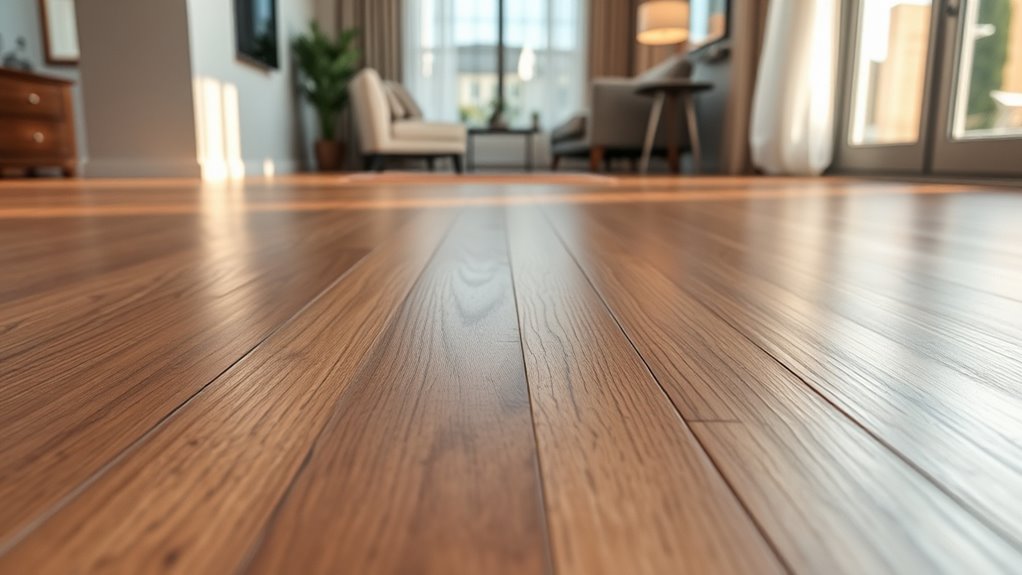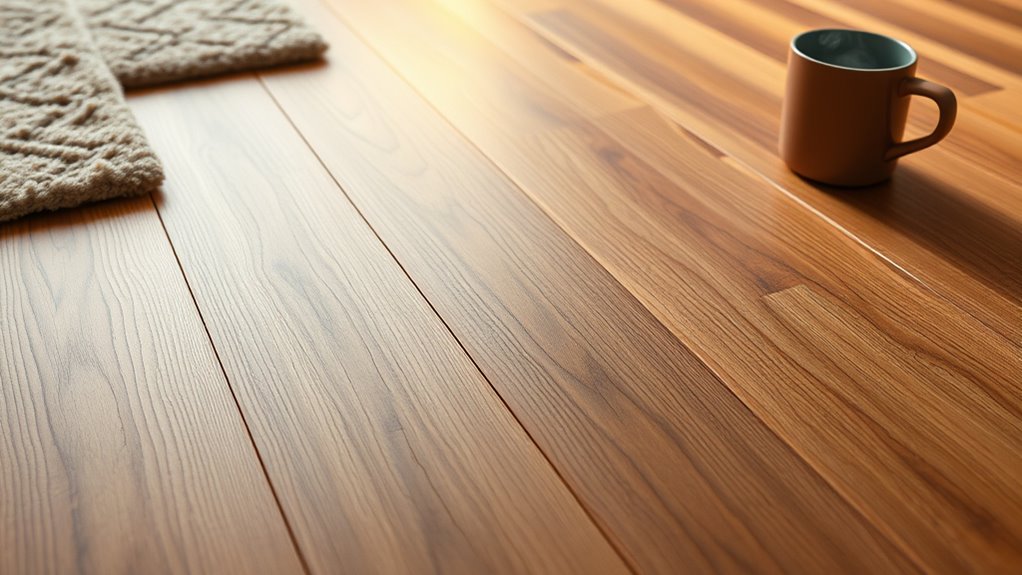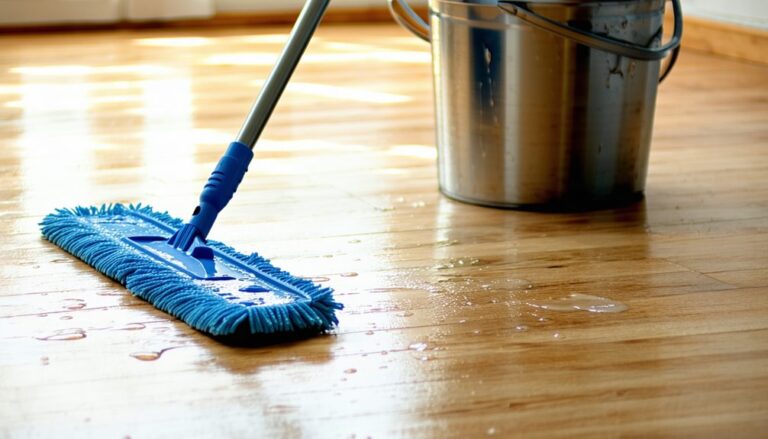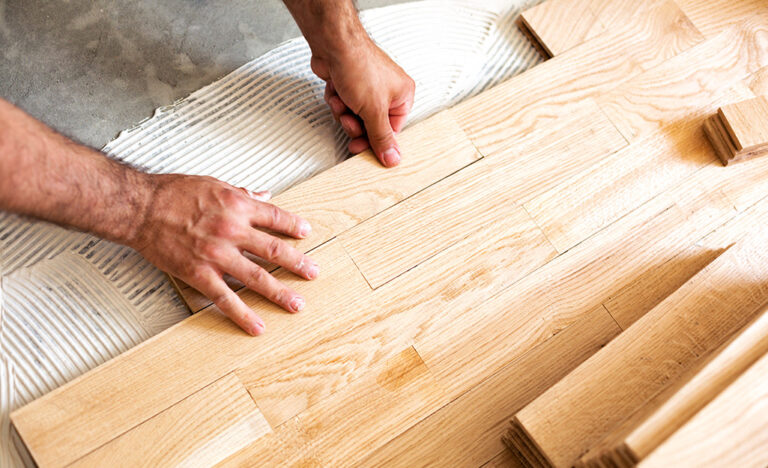Yes, you can install a heated floor under vinyl plank flooring, but it's essential to guarantee compatibility with the specific vinyl product. Electric and hydronic systems work well, but excessive heat may warp certain vinyls. Proper installation enhances efficiency and comfort while requiring regular maintenance and careful temperature control. Stick to recommended temperature settings to preserve the flooring's integrity. If you're curious about the benefits and potential drawbacks, there's more to explore on this topic.
Understanding Heated Flooring Systems

When considering heated flooring systems, it's vital to understand how they operate and their compatibility with various flooring types. These systems primarily utilize either electric or hydronic methods, each offering distinct heating efficiency benefits. Electric systems heat cables installed under the floor, while hydronic systems circulate warm water through pipes. For peak performance, you'll need to choose the right installation methods; improper installation can lead to uneven heating and increased energy costs. Verify your vinyl plank flooring is compatible with the heating system you select, as some materials may not withstand high temperatures. By understanding these fundamentals, you can make informed decisions that enhance comfort and efficiency in your living space.
Types of Vinyl Plank Flooring
While selecting the right type of vinyl plank flooring, it's essential to evaluate the various options available, as they can greatly impact your home's aesthetics and functionality. One popular option is luxury vinyl, which offers a high-end look with added durability. It's often designed to mimic natural materials like wood or stone, providing an attractive finish. Another option is rigid core vinyl, which features a sturdy construction that can withstand heavy foot traffic and resist dents. This type is especially beneficial in high-moisture areas, as it's less prone to warping. By understanding these types, you can choose the vinyl plank flooring that best meets your needs, ensuring a beautiful and lasting addition to your home.
Compatibility of Vinyl Plank With Heated Floors

Although many homeowners appreciate the comfort of heated floors, it's crucial to confirm that vinyl plank flooring is compatible with such systems. Vinyl characteristics, including its thermal conductivity, play a significant role in how well it interacts with heating elements. Most luxury vinyl planks are designed to withstand heat, but you must verify the specific product you choose is rated for use with heated floors. Typically, vinyl's ability to retain heat enhances heating efficiency, making it a desirable option for warmth. However, excessive heat can warp or damage some vinyl products, so always check manufacturer guidelines. By selecting the right vinyl plank, you can enjoy the cozy benefits of heated floors without compromising your flooring's integrity.
Benefits of Heated Floors Under Vinyl Plank
Heated floors beneath vinyl plank flooring offer a range of benefits that enhance both comfort and efficiency in your home. One of the most significant advantages is the comfort enhancement you'll experience, especially during colder months. Stepping onto a warm floor can make a substantial difference, creating a cozy atmosphere. Additionally, these systems promote energy efficiency; since heated floors distribute warmth evenly, you can maintain a comfortable temperature while potentially lowering your energy bills. This efficiency allows you to enjoy the luxury of warmth without sacrificing practicality. Furthermore, heated floors can reduce the need for bulky heating systems, giving you more freedom in your space. Overall, the combination of comfort and efficiency makes heated floors an excellent choice for vinyl plank installations.
Potential Drawbacks to Consider

When installing heated floors under vinyl plank flooring, you may encounter temperature regulation challenges, as achieving consistent warmth can be difficult. Additionally, moisture trapping issues can arise, potentially leading to mold growth if not properly managed. It is crucial to weigh these drawbacks against the benefits before proceeding with your installation.
Temperature Regulation Challenges
While heated floors can enhance comfort, they also present temperature regulation challenges that warrant careful consideration. You might experience temperature fluctuations that can affect the overall heating efficiency of your home. If the system isn't properly calibrated, certain areas may become excessively warm while others remain cool, leading to discomfort. Additionally, the type of vinyl plank flooring you choose can impact heat distribution; thicker planks may insulate against the heat, reducing the system's effectiveness. It's essential to install a reliable thermostat to monitor and adjust the temperature effectively, ensuring a balanced environment. Ultimately, understanding these challenges will help you make informed decisions about your heated flooring system, promoting both comfort and efficiency in your living space.
Moisture Trapping Issues
Although heated floors can provide a cozy ambiance, they may also contribute to moisture trapping issues that can compromise the integrity of your vinyl plank flooring. Here are some potential drawbacks to evaluate:
- Moisture Retention: Heated floors can create a warm, humid environment, leading to trapped moisture beneath the vinyl.
- Vinyl Expansion: Excess moisture can cause the vinyl to expand and warp, resulting in a distorted appearance.
- Mold Growth: Stagnant moisture can promote mold and mildew, impacting air quality and health.
- Increased Maintenance: You may need to monitor and manage moisture levels more diligently, increasing upkeep.
Understanding these factors can help you make informed decisions about installing heated flooring beneath vinyl planks.
Best Practices for Installation
When installing heated floors under vinyl plank flooring, careful preparation and planning are essential for success. You'll need to guarantee proper moisture barrier considerations to protect both the heating system and the flooring material. By following these best practices, you can achieve ideal performance and longevity of your installation.
Preparation and Planning
Before you begin installing heated floors under vinyl plank flooring, it's crucial to thoroughly prepare and plan to guarantee a successful project. Effective floor preparation and meticulous planning considerations can make all the difference. Here are some key steps to follow:
- Assess the Subfloor: Verify it's clean, dry, and level before installation.
- Choose the Right Heating System: Evaluate options, such as electric or hydronic systems, to suit your needs.
- Draft a Layout Plan: Map out where the heating elements will be installed to maximize efficiency.
- Check Manufacturer Guidelines: Always follow the specific requirements for both the heating system and vinyl plank flooring.
Moisture Barrier Considerations
To guarantee the longevity and performance of your heated floors under vinyl plank flooring, installing a moisture barrier is vital. Proper moisture control prevents water damage and mold growth, which can compromise your floor's integrity. When selecting vapor barriers, choose high-quality materials rated for your specific application. Make sure the barrier is installed correctly, covering the entire area beneath the flooring. Overlap seams and seal edges to enhance effectiveness. Additionally, consider the manufacturer's guidelines for both the heating system and the vinyl planks, as compatibility is essential. By prioritizing moisture control with an appropriate vapor barrier, you're not just protecting your investment; you're also assuring a comfortable living space that's less susceptible to humidity-related issues.
Recommended Heating Systems for Vinyl Plank
Selecting the right heating system for your vinyl plank flooring can greatly enhance comfort and efficiency. Here are some recommended options:
- Radiant Heating: This system warms the entire floor evenly, providing a cozy feel underfoot.
- Electric Mats: These thin mats can be installed under your vinyl planks, offering quick heat and easy installation.
- Hydronic Systems: Utilizing warm water, this energy-efficient option circulates heat through tubing beneath the floor.
- Foil Heating Systems: These systems reflect heat upwards, making them effective under vinyl without adding significant height.
Whichever system you choose, make sure it's compatible with vinyl plank flooring to maintain integrity and performance. Proper selection will allow you to enjoy a warm and inviting space effortlessly.
Maintenance Tips for Heated Vinyl Floors
To keep your heated vinyl floors in peak condition, regular cleaning practices are essential. You should also adhere to specific temperature control guidelines to prevent damage and guarantee efficient heating. By following these maintenance tips, you'll prolong the lifespan of your flooring and maintain its appearance.
Regular Cleaning Practices
While maintaining heated vinyl floors, regular cleaning practices are essential to guarantee their longevity and performance. To keep your floors looking great, follow these tips:
- Regular Vacuuming: Use a vacuum without a beater bar to prevent scratches and remove dirt effectively.
- Damp Mopping: Clean with a damp mop and a mild, pH-neutral cleaner to avoid damaging the vinyl.
- Stain Removal: Address spills immediately with a soft cloth or paper towel; for tough stains, use a specialized vinyl floor cleaner.
- Avoid Harsh Chemicals: Steer clear of abrasive cleaners or solvents, as they can harm the floor's surface.
Temperature Control Guidelines
Since maintaining the right temperature is essential for the performance of heated vinyl floors, it's important to follow specific guidelines to confirm ideal heating and comfort. First, set your temperature settings between 75°F and 85°F for maximum warmth. This range guarantees the floor feels cozy without risking damage to the vinyl. Avoid sudden temperature changes, as these can lead to expansion and contraction issues. Additionally, use a programmable thermostat to maintain consistent heating, preventing overheating during non-occupied hours. For best results, periodically check the floor's temperature with a reliable thermometer, confirming it aligns with your thermostat's readings. By adhering to these guidelines, you'll enjoy the benefits of heated vinyl floors while preserving their longevity and performance.
Cost Considerations for Installation
When considering heated floors under vinyl plank flooring, various cost factors come into play that can greatly affect your budget. Understanding these installation expenses is essential for effective budget planning. Here are some key considerations:
- Material Costs: The type of heating system and vinyl plank you choose can vary considerably in price.
- Labor Expenses: Professional installation may be necessary, adding to your overall costs.
- Electrical Requirements: Upgrading your electrical system to support heated floors can incur additional charges.
- Maintenance: Consider potential future maintenance costs associated with the heating system.
Alternative Flooring Options for Heated Systems
Considering heated floors under vinyl plank flooring opens up discussions about alternative flooring options that can also accommodate radiant heating systems. Two popular choices are luxury vinyl and laminate flooring, both of which can seamlessly integrate with heating systems.
Here's a quick comparison:
| Flooring Type | Compatibility with Heated Systems |
|---|---|
| Luxury Vinyl | Excellent |
| Laminate Flooring | Good |
| Engineered Wood | Moderate |
| Tile Flooring | Excellent |
| Carpet | Limited |
Luxury vinyl offers durability and moisture resistance, making it ideal for heated applications. Laminate flooring, while slightly less effective, still provides a comfortable feel underfoot. Choosing the right flooring will enhance your space while ensuring comfort and efficiency.
Frequently Asked Questions
Can Heated Floors Damage Vinyl Plank Flooring Over Time?
Heated floors can potentially damage vinyl plank flooring over time. The long-term effects often include floor expansion due to heat fluctuations, which might lead to warping or gaps. If you decide to use heated floors, it's essential to monitor the temperature settings to avoid excessive heat. Maintaining a consistent, moderate temperature can help mitigate these risks and preserve the integrity of your vinyl flooring. Always consult manufacturer guidelines for the best results.
What Temperature Is Safe for Vinyl Plank Flooring With Heated Systems?
Imagine stepping onto warm floors on a chilly morning, but you've gotta make sure the temperature's just right. For vinyl plank flooring with heated systems, the safe temperature limit is typically around 80°F (27°C). Exceeding this can warp or damage flooring materials, compromising their integrity over time. It's essential to monitor your heating system closely to maintain that cozy feel without risking your beautiful vinyl planks. Enjoy the warmth, but keep it within those limits!
How Do I Know if My Vinyl Plank Is Compatible With Heating?
To determine if your vinyl plank is compatible with heating systems, check the manufacturer's specifications for your specific vinyl plank types. Look for indications that it's rated for use with radiant heat. Additionally, verify that the maximum temperature of the heating system doesn't exceed the limits recommended for your flooring. If you're uncertain, consulting with a flooring professional can provide clarity and help you make an informed decision for your project.
Can I Use Area Rugs on Top of Heated Vinyl Floors?
Yes, you can use area rugs on top of heated vinyl floors, but you should be cautious about the materials. Select breathable rug materials like cotton or wool, as synthetic options can trap heat and damage the flooring. For rug placement tips, make sure the rug isn't too thick, allowing heat to circulate. Also, avoid placing rugs directly over heating elements to prevent overheating and guarantee effective heating throughout your space.
Will Heated Floors Increase My Energy Bills Significantly?
Heated floors can indeed impact your energy bills, though the extent varies. When considering energy efficiency, radiant heating systems often warm spaces more effectively than traditional heating methods, leading to potential savings. A cost comparison might reveal that while initial expenses can be higher, the long-term benefits, such as reduced reliance on your main heating system, could offset those costs. It's worth evaluating your specific situation to determine the overall financial impact.




